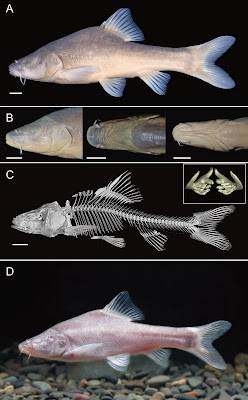Abstract
Sinocyclocheilus guiyang, a new troglobitic species from a subterranean tributary of the upper Yangtze Basin in Guiyang City, Guizhou Province, China is described in the present study. The new species is distinguishable from its congeneric species by a combination of the following characters: tip of maxillary barbel reaching to posterior edge of orbit; forehead horn absent; eye absent (or highly reduced) and tip of pectoral fins not significantly extending beyond the base of the pelvic fin. Molecular evidence, based on the mitochondrial cytochrome b (cytb) gene, further supports the validity of the species and also reveals its close relationship with S. cyphotergous, S. multipunctatus, S. punctatus and S. sanxiaensis. In addition, the new species faces a high risk of extinction, underscoring the urgency for habitat protection measures within its limited range.
Key Words: cavefish, conservation, morphology, phylogenetic analysis, Yangtze River
Sinocyclocheilus guiyang sp. nov.
Diagnosis: Sinocyclocheilus guiyang is distinguishable from all other congeners by a combination of the following characters: tip of maxillary barbel not reaching to posterior edge of preoperculum, horn-like structure in forehead absent, eye absent or highly reduced, pectoral fin not significantly extending beyond base of pelvic fin. The major diagnostic characters for S. guiyang and related species are summarised in Table 3.
...
Etymology: The location of the subterranean stream where this new species was first collected: Guiyang City, the capital of Guizhou Province, is directly utilised as a specific epithet. The common name proposed for the new species is ‘贵阳金线鲃’ (Guiyang Golden-line Barbel).
 |
| Habitat of Sinocyclocheilus guiyang. A. The pool of a subterranean stream where S. guiyang was collected; B. S. guiyang in situ. |
Wei-Han Shao, Guang-Yuan Cheng, Xiao-Long Lu, Jia-Jun Zhou and Zhi-Xuan Zeng. 2024. Description of A New troglobitic Sinocyclocheilus (Pisces, Cyprinidae) species from the upper Yangtze River Basin in Guizhou, South China. Zoosystematics and Evolution. 100(2): 515-529. DOI: 10.3897/zse.100.119520





